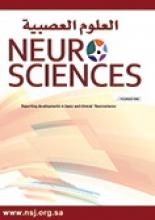Abstract
OBJECTIVE: To determine the prevalence, clinical manifestations, and laboratory features of Neuro-Behcet’s disease.
METHODS: This prospective study was carried out in the Behcet’s Research Clinic in Shiraz (south-west Iran) and included the patients referred from 1990-1999. The patients’ clinical records, images, CSF analyses, and electrodiagnostic studies were reviewed.
RESULTS: Eighteen (15 males and 3 females) out of 690 Behcet’s patients (2.6%, 95% CI = 1.4-3.8%) were found to have neurological involvement. The mean +/- standard deviation age of these patients was 34.7+/-8.6 years. All fulfilled the criteria of the International Study Group of Behcet’s Disease. Central nervous system involvement was more common than peripheral nervous system manifestations. Headache, weakness, tingling, and numbness were the most common symptoms. Hyperreflexia, upward plantar reflex, and somatosensory findings were the most frequent signs. Hemispheral and brainstem stroke-like syndromes and cerebral venous thrombosis were the major neurologic presentations. There were also cases of myelitic, pure meningoencephalitic, amyotrophic lateral sclerosis-like, multiple sclerosis-like, and Guillain Barre syndromes.
CONCLUSION: Neuro-Behcet’s disease must be considered in the differential diagnosis of stroke in young adults, chronic meningitis, intracranial hypertension, multiple sclerosis, myelopathies, and peripheral neuropathies.
- Copyright: © Neurosciences
Neurosciences is an Open Access journal and articles published are distributed under the terms of the Creative Commons Attribution-NonCommercial License (CC BY-NC). Readers may copy, distribute, and display the work for non-commercial purposes with the proper citation of the original work.






